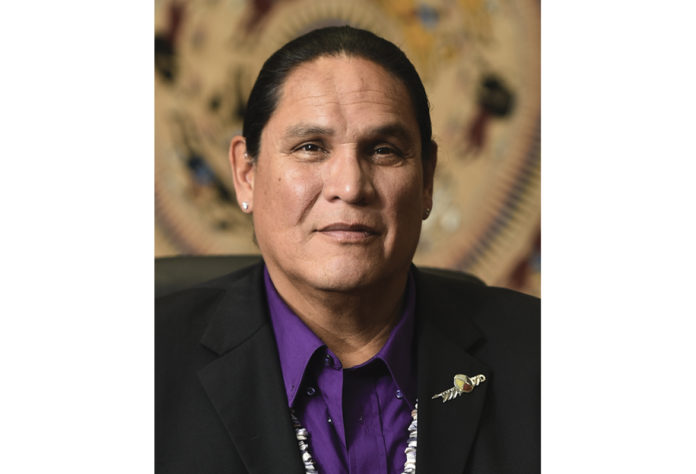by Ernest L. Stevens, Jr.
On the heels of record-breaking attendance at the annual Indian Gaming Tradeshow and Convention, the Indian gaming industry received more astounding news from the fiscal year 2022. During IGA’s four-day Tradeshow & Convention in San Diego, we released our 2022 Nationwide Impacts of Indian Gaming Report.
The report confirmed continued steady growth for our industry, building upon FY 2021’s record number. The Indian gaming industry built on the historic post-Covid rebound in 2021 when Indian gaming revenue topped $39 billion, a 40 percent increase over 2020 and a 13 percent increase over our industry’s pre-pandemic high of $34.6 billion.
In 2022, 246 tribal governments operating 504 facilities in 29 states generated approximately $43 billion in gross revenue. And a steady 10 percent increase over 2021. Tribal government gaming operations generated an additional $5.3 billion in gross revenue from ancillary/gaming-related enterprises, including hotels, restaurants, entertainment, and related operations. As a result, Indian gaming accounted for a total of $48.4 billion in direct gross revenues in 2022.
These numbers continue to reflect the vision of tribal leaders who put their communities first throughout the pandemic. Their decisions helped grow trust and confidence in our operations, and that trust continued to grow in 2022. This additional revenue will have profound impacts on our tribal nations and our neighboring communities nationwide.
Other key data points from our 2022 Impacts Report also confirm Indian gaming’s strong employment record. It has been a constant mantra for the Indian Gaming Association, but it’s worth repeating – Indian gaming has always been first and foremost about jobs.
In 2022, Indian gaming delivered more than 680,000 jobs for American families. Of this total, 38.7 percent, or 264,963, were direct jobs, and 61.2 percent, or 419,195, represented indirect jobs. These indirect jobs are generated from Indian gaming wages, purchasing activity, capital expansion, and related activities. As a result, Indian gaming remains among the top 20 employers in the United States.
Related reports on the historical impacts of Indian gaming over the past several decades confirm that these jobs are bringing Native Americans back to Indian Country. Studies from the Harvard Project on tribal communities, Congressional Budget Office, and others consistently show that in the four years after a tribal gaming operation opens, that tribe’s reservation sees a 12 percent population rise on Indian lands, adult employment increases by 26 percent, and the community sees a 14 percent decline in the number of working poor.
In 2022, Indian gaming operations directly transferred nearly $21 billion to tribal governments. A large portion of these direct transfers goes to cover wages and employee benefits. These dollars are spent locally, staying in the region.
After overhead costs are met, tribal governments dedicate the net proceeds of Indian gaming operations to essential government services. The distribution of gaming revenues is the distinguishing factor between commercial gaming, whose revenues go to shareholders and management, and tribal gaming. Tribal governments must use their gaming revenues to help revitalize Native communities nationwide.
Tribes use gaming revenues to improve the lives of those living on Indian lands. Indian gaming revenues build homes and improve health care, education, public safety, and social programs for Native youth and elders. Gaming revenues help rebuild a wide range of infrastructure, including roads, water and wastewater systems, communications systems, and much more. Over the past several decades, our industry is also preserving and reviving Native culture, language, and traditions. In 2022, Indian gaming operations again delivered significant positive economic and social impacts throughout Indian Country.
However, the benefits of Indian gaming do not stop at the reservation border. Our 2022 impact report shows that nearly 3 in 4 direct jobs created by Indian gaming go to our non-Native neighbors. A related 2019 report on Indian gaming impacts concluded that counties with or near Indian gaming operations see increases in the employment-to-population ratio and decreases in mortality rates.
In 2022, Indian Gaming was responsible for generating $37 billion in direct and indirect wages throughout Indian Country and nearby communities. Indian gaming operations paid nearly $8 billion in wages to their direct employees. Our industry generated an additional $29 billion in wages that resulted from Indian gaming employees spending their disposable incomes, casino operations purchasing activities, capital expansion projects, and transfer payment spending activities.
In 2022, Indian gaming was responsible for generating $11.5 billion in federal taxes, $4.6 billion in state taxes, and $1.4 billion in county taxes – a total of $17.5 billion.
Over the past decade, Indian Gaming has delivered more than $140 billion to the federal and state governments in the form of employment, income, sales, and other taxes, and reduced general welfare payments. Of this total, tribes shared more than $15 billion to state governments through revenue-sharing agreements codified in tribal-state gaming compacts.
Our 2022 Impact Report did not examine charitable contributions, but public information confirms that tribal governments continue to donate more than $100 million annually to other tribal governments, nearby state and local governments, and non-profits.
Indian gaming has also increased the political participation of tribal governments and individual Native Americans nationwide. One positive outgrowth of this increased participation is that many Native people are now seeking office in the state and local government. A record 140 indigenous candidates sought federal and state offices in the November 2022 election.
The economic impacts of Indian gaming are profound. Our industry continues to revitalize not only tribal communities nationwide but also our nearby, mostly rural neighboring communities. The Biden Administration recently summed up tribal gaming’s success and future endeavors when it declared that “the Indian gaming industry remains one of the most significant sources of tribal economic development in Indian Country…. Evolving technology should not be an impediment to tribes participating in the gaming industry.”
The Indian Gaming Association is proud to report that the state of the Indian gaming industry is strong, and our tribal governments deserve all of the credit. But we cannot rest. There is growing competition for the American gaming dollar, and emerging markets present both challenges and opportunities for our industry. We look forward to meeting these challenges together as a united Indian Country, preparing future generations for the next round of successful economic development on the reservation.
Ernest L. Stevens, Jr. is Chairman of the Indian Gaming Association. He can be reached by calling (202) 546-7711 or visit www.indiangaming.org.













































